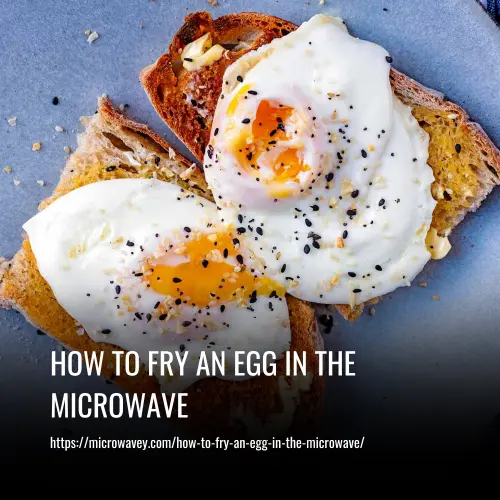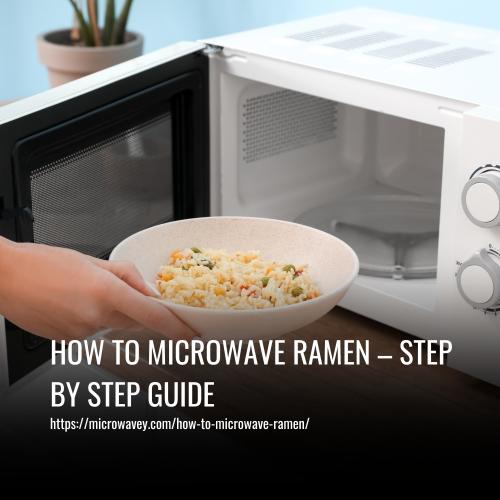How to Fry An Egg In The Microwave: A Step-by-Step Guide
Microwaving an egg might sound unconventional, but it’s actually a fast and convenient method that yields perfectly cooked eggs in a matter of minutes. With just a few simple steps, you can have a delicious fried egg ready to enjoy in no time.
To fry an egg in the microwave, follow these steps:
- Step 1: Choose a microwave-safe plate
- Step 2: Crack the egg onto the plate
- Step 3: Pierce the yolk
- Step 4: Season the egg
- Step 5: Microwave the egg
- Step 6: Let the egg rest
- Step 7: Transfer and serve

How to Fry An Egg In The Microwave: Step by Step Guide
What You’ll Need
- A microwave-safe plate
- An egg
- A fork
- Salt and pepper (optional)
Step by Step Guide
Step 1: Choose a microwave-safe plate: To start, select a plate that is microwave-safe and large enough to hold the egg without overflow.
Step 2: Crack the egg onto the plate: Next, crack the egg directly onto the plate, being careful not to break the yolk. You can also crack the egg into a separate bowl first if you prefer.
Step 3: Pierce the yolk: Using a fork, gently pierce the yolk of the egg to prevent it from exploding during cooking.
Step 4: Season the egg: Season the egg with a pinch of salt and pepper, or any other desired spices to enhance the flavor.
Step 5: Microwave the egg: Place the plate in the microwave and cook on high power for 45 seconds to 1 minute. Keep an eye on the egg to avoid overcooking.
Step 6: Let the egg rest: Once cooked, let the egg rest for a minute to finish cooking and set. This will ensure the yolk is cooked to your preference.
Step 7: Transfer and serve: Using a spatula or fork, carefully transfer the fried egg onto a plate or toasted bread. Enjoy your perfectly cooked fried egg straight from the microwave!
Is It Safe To Eat Fried Eggs Cooked In The Microwave
Eating fried eggs cooked in the microwave is generally safe. However, it’s important to follow proper cooking guidelines to ensure the eggs are fully cooked and safe to eat. Cooking eggs in the microwave can be quick and convenient, but make sure to use a microwave-safe dish and avoid overcooking to prevent the eggs from becoming rubbery. Enjoy your microwave-fried eggs in moderation as part of a balanced diet.
How Long Do You Microwave Fried Eggs
Microwaving fried eggs is a quick and convenient way to cook them. The cooking time can vary depending on the wattage of your microwave and the number of eggs being fried. For a 1000 watt microwave, it typically takes around one minute to microwave fried eggs.
However, it’s essential to monitor the eggs closely to prevent overcooking and ensure they are cooked to your desired level of doneness. It’s recommended to start with a shorter cooking time and adjust as needed based on the results. Enjoy your microwaved fried eggs!
Tips to Microwave Fried Eggs
If you’re looking for a quick and easy way to fry an egg, try using the microwave. Here are some tips and tricks to help you achieve the perfect fried egg:
1. Experiment with cooking times: Adjust the cooking time to achieve your preferred level of doneness. If you like a runny yolk, cook the egg for a shorter time. For a fully cooked yolk, increase the cooking time slightly.
2. Add toppings for extra flavor: Feel free to get creative with your fried egg by adding cheese, vegetables, or bacon bits on top before cooking. This will add variety and flavor to your dish.
3. Be cautious when handling the hot plate: Remember to use oven mitts or a towel to protect your hands when handling the plate after cooking. The plate can get very hot, so take precautions to avoid burns.
By following these tips and tricks, you can easily whip up a delicious fried egg in the microwave whenever you’re craving a quick and tasty meal. Enjoy your perfectly fried egg!
FAQs
Yes, you can fry an egg in the microwave. It may not be the traditional way, but it’s quick and easy. Just crack the egg into a microwave-safe dish, pierce the yolk, and cook in short bursts until it’s done to your liking.
Yes, you can reheat fried eggs in the microwave for about 30 seconds to warm them up without overcooking them. Just be sure not to leave them in for too long to prevent them from becoming dry and rubbery.
Crack the egg into a microwave-safe dish and lightly beat it or leave it whole. Then, microwave it for about 1 minute, making sure to stop and stir every 20 seconds. Make sure the egg is fully cooked before eating.
It is a good idea to add a little oil or cooking spray to the dish before frying an egg in the microwave. This will help prevent the egg from sticking to the dish and make it easier to remove once it’s cooked.
Yes, you can season the egg with salt, pepper, or any other spices before cooking it in the microwave. Just be careful not to add too much seasoning because the flavors can get stronger when the egg is cooking.
Yes, there are some safety precautions to follow when microwaving an egg. Use a microwave-safe dish and cover it with a microwave-safe plate to avoid splattering. Be careful when taking the dish out of the microwave as it can be hot.
Conclusion
In conclusion, frying an egg in the microwave is a quick and easy way to enjoy a delicious breakfast without the hassle of using a stove. Just remember to use a microwave-safe dish, pierce the yolk to prevent explosions, and keep an eye on the cooking time. With these simple tips, you’ll be able to enjoy a perfectly fried egg in minutes. Happy cooking!




